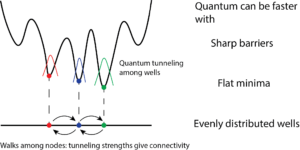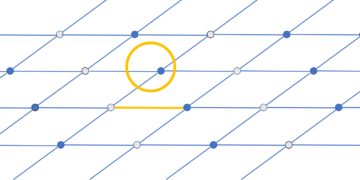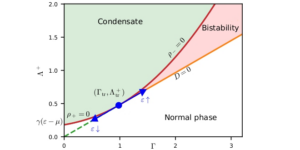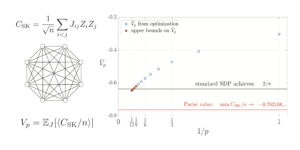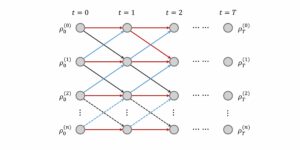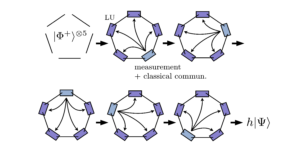1Department of Microtechnology and Nanoscience (MC2), Chalmers University of Technology, SE-412 96 Göteborg, Sweden
2Centre for Theoretical Atomic, Molecular and Optical Physics, Queen’s University Belfast, Belfast BT7 1NN, United Kingdom
3Dipartimento di Fisica “Aldo Pontremoli,” Università degli Studi di Milano, I-20133 Milano, Italy
Find this paper interesting or want to discuss? Scite or leave a comment on SciRate.
Abstract
We study the classical simulatability of Gottesman-Kitaev-Preskill (GKP) states in combination with arbitrary displacements, a large set of symplectic operations and homodyne measurements. For these types of circuits, neither continuous-variable theorems based on the non-negativity of quasi-probability distributions nor discrete-variable theorems such as the Gottesman-Knill theorem can be employed to assess the simulatability. We first develop a method to evaluate the probability density function corresponding to measuring a single GKP state in the position basis following arbitrary squeezing and a large set of rotations. This method involves evaluating a transformed Jacobi theta function using techniques from analytic number theory. We then use this result to identify two large classes of multimode circuits which are classically efficiently simulatable and are not contained by the GKP encoded Clifford group. Our results extend the set of circuits previously known to be classically efficiently simulatable.
Featured image: The circuit diagram of arbitrary circuits selected from the simulatable class $mathcal B$ of simulatable circuits with multimode measurements, as presented in our work. The first action of the circuit on the modes is a rotation of each mode with angles $theta_i$ selected from a set of allowed angles. This is followed by arbitrary squeezing of each mode. The next operation is selected from the intersection of the general linear group $text{GL}(n,mathbb R)$ and the subset of symmetric positive definite symplectic matrices $Pi(n)$ in $text{Sp}(2n,mathbb R)$, yielding $text{GL}(n,mathbb R)cap Pi(n)$. The final operation is selected from the lens subgroup of symplectic matrices, $mathcal T$. Finally, the modes are measured in the position basis with homodyne detection. We note that arbitrary phase space displacements can be inserted into the circuit due to the fact that they preserve the structure of the symplectic matrix.
Popular summary
We focus on quantum computer architectures whereby the information is encoded into continuous variables (CVs). This approach relies on quantized variables with a continuous spectrum, such as the position and momentum quadratures of the electromagnetic field. An example of such an encoding procedure is known as the Gottesman-Kitaev-Preskill (GKP) encoding, using GKP states. Architectures using this encoding allow for increased resilience to noise, with respect to architectures using discrete-variable systems.
Our work demonstrates that a large class of quantum circuits with input GKP states prepared to encode computational states such as 0 and 1 is efficiently simulatable with classical computers. We, therefore, demonstrate that these circuits are not capable of achieving quantum advantage. Our findings contribute therefore to drawing a divide between computationally useful and useless architectures of quantum computers.
► BibTeX data
► References
[1] Aram W Harrow and Ashley Montanaro. “Quantum computational supremacy”. Nature 549, 203 (2017).
https://doi.org/10.1038/nature23458
[2] Daniel Gottesman, Alexei Kitaev, and John Preskill. “Encoding a qubit in an oscillator”. Physical Review A 64, 012310 (2001).
https://doi.org/10.1103/PhysRevA.64.012310
[3] Arne L. Grimsmo, Joshua Combes, and Ben Q. Baragiola. “Quantum computing with rotation-symmetric bosonic codes”. Physical Review X 10, 011058 (2020).
https://doi.org/10.1103/PhysRevX.10.011058
[4] Atharv Joshi, Kyungjoo Noh, and Yvonne Y Gao. “Quantum information processing with bosonic qubits in circuit QED”. Quantum Science and Technology 6, 033001 (2021).
https://doi.org/10.1088/2058-9565/abe989
[5] Arne L. Grimsmo and Shruti Puri. “Quantum error correction with the gottesman-kitaev-preskill code”. PRX Quantum 2, 020101 (2021).
https://doi.org/10.1103/PRXQuantum.2.020101
[6] Timo Hillmann, Fernando Quijandría, Arne L. Grimsmo, and Giulia Ferrini. “Performance of teleportation-based error-correction circuits for bosonic codes with noisy measurements”. PRX Quantum 3, 020334 (2022).
https://doi.org/10.1103/PRXQuantum.3.020334
[7] Nissim Ofek, Andrei Petrenko, Reinier Heeres, Philip Reinhold, Zaki Leghtas, Brian Vlastakis, Yehan Liu, Luigi Frunzio, S. M. Girvin, L. Jiang, Mazyar Mirrahimi, M. H. Devoret, and R. J. Schoelkopf. “Extending the lifetime of a quantum bit with error correction in superconducting circuits”. Nature 536, 441–445 (2016).
https://doi.org/10.1038/nature18949
[8] Christa Flühmann, Thanh Long Nguyen, Matteo Marinelli, Vlad Negnevitsky, Karan Mehta, and JP Home. “Encoding a qubit in a trapped-ion mechanical oscillator”. Nature 566, 513 (2019).
https://doi.org/10.1038/s41586-019-0960-6
[9] L. Hu, Y. Ma, W. Cai, X. Mu, Y. Xu, W. Wang, Y. Wu, H. Wang, Y. P. Song, C.-L. Zou, S. M. Girvin, L.-M. Duan, and L. Sun. “Quantum error correction and universal gate set operation on a binomial bosonic logical qubit”. Nature Physics 15, 503–508 (2019).
https://doi.org/10.1038/s41567-018-0414-3
[10] Philippe Campagne-Ibarcq, Alec Eickbusch, Steven Touzard, Evan Zalys-Geller, Nicholas E Frattini, Volodymyr V Sivak, Philip Reinhold, Shruti Puri, Shyam Shankar, Robert J Schoelkopf, et al. “Quantum error correction of a qubit encoded in grid states of an oscillator”. Nature 584, 368–372 (2020).
https://doi.org/10.1038/s41586-020-2603-3
[11] Marina Kudra, Mikael Kervinen, Ingrid Strandberg, Shahnawaz Ahmed, Marco Scigliuzzo, Amr Osman, Daniel Pérez Lozano, Mats O. Tholén, Riccardo Borgani, David B. Haviland, Giulia Ferrini, Jonas Bylander, Anton Frisk Kockum, Fernando Quijandría, Per Delsing, and Simone Gasparinetti. “Robust preparation of wigner-negative states with optimized SNAP-Displacement sequences”. PRX Quantum 3, 030301 (2022).
https://doi.org/10.1103/PRXQuantum.3.030301
[12] Christophe Vuillot, Hamed Asasi, Yang Wang, Leonid P Pryadko, and Barbara M Terhal. “Quantum error correction with the toric Gottesman-Kitaev-Preskill code”. Physical Review A 99, 032344 (2019).
https://doi.org/10.1103/PhysRevA.99.032344
[13] Kyungjoo Noh and Christopher Chamberland. “Fault-tolerant bosonic quantum error correction with the surface–Gottesman-Kitaev-Preskill code”. Physical Review A: Atomic, Molecular, and Optical Physics 101, 012316 (2020).
https://doi.org/10.1103/PhysRevA.101.012316
[14] Kyungjoo Noh, Christopher Chamberland, and Fernando G.S.L. Brandão. “Low-overhead fault-tolerant quantum error correction with the surface-GKP code”. PRX Quantum 3, 010315 (2022).
https://doi.org/10.1103/PRXQuantum.3.010315
[15] Laura García-Álvarez, Alessandro Ferraro, and Giulia Ferrini. “From the bloch sphere to phase-space representations with the Gottesman–Kitaev–Preskill encoding”. In Tsuyoshi Takagi, Masato Wakayama, Keisuke Tanaka, Noboru Kunihiro, Kazufumi Kimoto, and Yasuhiko Ikematsu, editors, International Symposium on Mathematics, Quantum Theory, and Cryptography. Pages 79–92. Singapore (2021). Springer Singapore.
https://doi.org/10.1007/978-981-15-5191-8_9
[16] Hayata Yamasaki, Takaya Matsuura, and Masato Koashi. “Cost-reduced all-Gaussian universality with the Gottesman-Kitaev-Preskill code: Resource-theoretic approach to cost analysis”. Physical Review Research 2, 023270 (2020).
https://doi.org/10.1103/PhysRevResearch.2.023270
[17] A. Mari and J. Eisert. “Positive wigner functions render classical simulation of quantum computation efficient”. Physical Review Letters 109, 230503 (2012).
https://doi.org/10.1103/PhysRevLett.109.230503
[18] Victor Veitch, Christopher Ferrie, David Gross, and Joseph Emerson. “Negative quasi-probability as a resource for quantum computation”. New Journal of Physics 14, 113011 (2012).
https://doi.org/10.1088/1367-2630/14/11/113011
[19] Francesco Albarelli, Marco G. Genoni, Matteo G. A. Paris, and Alessandro Ferraro. “Resource theory of quantum non-Gaussianity and Wigner negativity”. Physical Review A 98, 052350 (2018).
https://doi.org/10.1103/PhysRevA.98.052350
[20] Ryuji Takagi and Quntao Zhuang. “Convex resource theory of non-Gaussianity”. Physical Review A 97, 062337 (2018).
https://doi.org/10.1103/PhysRevA.97.062337
[21] Ben Q. Baragiola, Giacomo Pantaleoni, Rafael N. Alexander, Angela Karanjai, and Nicolas C. Menicucci. “All-gaussian universality and fault tolerance with the gottesman-kitaev-preskill code”. Physical Review Letters 123, 200502 (2019).
https://doi.org/10.1103/PhysRevLett.123.200502
[22] Laura García-Álvarez, Cameron Calcluth, Alessandro Ferraro, and Giulia Ferrini. “Efficient simulatability of continuous-variable circuits with large Wigner negativity”. Physical Review Research 2, 043322 (2020).
https://doi.org/10.1103/PhysRevResearch.2.043322
[23] Daniel Gottesman. “The Heisenberg representation of quantum computers”. Pages 32–43. Group22: Proceedings of the XXII International Colloquium on Group Theoretical Methods in Physics. Cambridge, MA, International Press. (1999). arXiv:quant-ph/9807006.
arXiv:quant-ph/9807006
[24] Stephen D. Bartlett, Barry C. Sanders, Samuel L. Braunstein, and Kae Nemoto. “Efficient classical simulation of continuous variable quantum information processes”. Physical Review Letters 88, 097904 (2002).
https://doi.org/10.1103/PhysRevLett.88.097904
[25] Scott Aaronson and Daniel Gottesman. “Improved simulation of stabilizer circuits”. Physical Review A 70, 052328 (2004).
https://doi.org/10.1103/PhysRevA.70.052328
[26] Maarten Van Den Nest. “Classical simulation of quantum computation, the Gottesman-Knill theorem, and slightly beyond”. Quantum Information & Computation 10, 258–271 (2010).
https://doi.org/10.26421/QIC10.3-4-6
[27] Niel de Beaudrap. “A linearized stabilizer formalism for systems of finite dimension”. Quantum Information & Computation 13, 73–115 (2013).
https://doi.org/10.26421/QIC13.1-2-6
[28] Vlad Gheorghiu. “Standard form of qudit stabilizer groups”. Physics Letters A 378, 505–509 (2014).
https://doi.org/10.1016/j.physleta.2013.12.009
[29] Victor Veitch, S. A. Hamed Mousavian, Daniel Gottesman, and Joseph Emerson. “The resource theory of stabilizer quantum computation”. New Journal of Physics 16, 013009 (2014).
https://doi.org/10.1088/1367-2630/16/1/013009
[30] Juani Bermejo-Vega. “Normaliser circuits and quantum computation”. PhD Thesis, Technische Universität München Max-Planck-Institut für Quantenoptik (2016).
https://doi.org/10.48550/arXiv.1611.09274
[31] Juani Bermejo-Vega and Maarten Van Den Nest. “Classical simulations of Abelian-group normalizer circuits with intermediate measurements”. Quantum Information & Computation 14, 181–216 (2014).
https://doi.org/10.26421/QIC14.3-4-1
[32] K. E. Cahill and R. J. Glauber. “Ordered expansions in boson amplitude operators”. Physical Review 177, 1857–1881 (1969).
https://doi.org/10.1103/PhysRev.177.1857
[33] Saleh Rahimi-Keshari, Timothy C. Ralph, and Carlton M. Caves. “Sufficient conditions for efficient classical simulation of quantum optics”. Physical Review X 6, 021039 (2016).
https://doi.org/10.1103/PhysRevX.6.021039
[34] Samuel L Braunstein and Peter Van Loock. “Quantum information with continuous variables”. Reviews of Modern Physics 77, 513 (2005).
https://doi.org/10.1103/RevModPhys.77.513
[35] Mile Gu, Christian Weedbrook, Nicolas C. Menicucci, Timothy C. Ralph, and Peter van Loock. “Quantum computing with continuous-variable clusters”. Physical Review A: Atomic, Molecular, and Optical Physics 79, 062318 (2009).
https://doi.org/10.1103/PhysRevA.79.062318
[36] Alessandro Ferraro, Stefano Olivares, and Matteo G. A. Paris. “Gaussian states in quantum information”. Bibliopolis. Napoli (2005).
https://doi.org/10.48550/arXiv.quant-ph/0503237
arXiv:quant-ph/0503237
[37] Alessio Serafini. “Quantum continuous variables : A primer of theoretical methods”. CRC Press, Taylor & Francis Group. Boca Raton, FL (2017).
https://doi.org/10.1201/9781315118727
[38] Arvind, B Dutta, N Mukunda, and R Simon. “The real symplectic groups in quantum mechanics and optics”. Pramana J. Phys. 45, 441–497 (1995).
https://doi.org/10.1007/BF02848172
[39] M. F. Atiyah and I. G. Macdonald. “Introduction to Commutative Algebra”. CRC Press. Boca Raton (2019).
https://doi.org/10.1201/9780429493621
[40] Richard Jozsa and Marrten Van Den Nest. “Classical simulation complexity of extended clifford circuits”. Quantum Information & Computation 14, 633–648 (2014).
https://doi.org/10.26421/qic14.7-8-7
[41] Barbara M. Terhal and David P. DiVincenzo. “Adaptive quantum computation, constant depth quantum circuits and arthur-merlin games”. Quantum Info. Comput. 4, 134–145 (2004).
https://doi.org/10.26421/QIC4.2-5
[42] Michael J. Bremner, Richard Jozsa, and Dan J. Shepherd. “Classical simulation of commuting quantum computations implies collapse of the polynomial hierarchy”. Proceedings of the Royal Society A: Mathematical, Physical and Engineering Sciences 467, 459–472 (2011).
https://doi.org/10.1098/rspa.2010.0301
[43] J. Eli Bourassa, Nicolás Quesada, Ilan Tzitrin, Antal Száva, Theodor Isacsson, Josh Izaac, Krishna Kumar Sabapathy, Guillaume Dauphinais, and Ish Dhand. “Fast simulation of bosonic qubits via gaussian functions in phase space”. PRX Quantum 2, 040315 (2021).
https://doi.org/10.1103/PRXQuantum.2.040315
[44] Mikkel V. Larsen, Christopher Chamberland, Kyungjoo Noh, Jonas S. Neergaard-Nielsen, and Ulrik L. Andersen. “Fault-tolerant continuous-variable measurement-based quantum computation architecture”. PRX Quantum 2, 030325 (2021).
https://doi.org/10.1103/PRXQuantum.2.030325
[45] Mithuna Yoganathan, Richard Jozsa, and Sergii Strelchuk. “Quantum advantage of unitary clifford circuits with magic state inputs”. Proc. R. Soc. A 475 (2019).
https://doi.org/10.1098/rspa.2018.0427
[46] Volker Mehrmann. “A Symplectic Orthogonal Method for Single Input or Single Output Discrete Time Optimal Quadratic Control Problems”. SIAM Journal on Matrix Analysis and Applications 9, 221–247 (1988).
https://doi.org/10.1137/0609019
[47] Froilán M. Dopico and Charles R. Johnson. “Parametrization of the Matrix Symplectic Group and Applications”. SIAM Journal on Matrix Analysis and Applications 31, 650–673 (2009).
https://doi.org/10.1137/060678221
[48] Frank Arute, Kunal Arya, Ryan Babbush, Dave Bacon, Joseph C. Bardin, Rami Barends, Rupak Biswas, Sergio Boixo, Fernando G. S. L. Brandao, David A. Buell, Brian Burkett, Yu Chen, Zijun Chen, Ben Chiaro, Roberto Collins, William Courtney, Andrew Dunsworth, Edward Farhi, Brooks Foxen, Austin Fowler, Craig Gidney, Marissa Giustina, Rob Graff, Keith Guerin, Steve Habegger, Matthew P. Harrigan, Michael J. Hartmann, Alan Ho, Markus Hoffmann, Trent Huang, Travis S. Humble, Sergei V. Isakov, Evan Jeffrey, Zhang Jiang, Dvir Kafri, Kostyantyn Kechedzhi, Julian Kelly, Paul V. Klimov, Sergey Knysh, Alexander Korotkov, Fedor Kostritsa, David Landhuis, Mike Lindmark, Erik Lucero, Dmitry Lyakh, Salvatore Mandrà, Jarrod R. McClean, Matthew McEwen, Anthony Megrant, Xiao Mi, Kristel Michielsen, Masoud Mohseni, Josh Mutus, Ofer Naaman, Matthew Neeley, Charles Neill, Murphy Yuezhen Niu, Eric Ostby, Andre Petukhov, John C. Platt, Chris Quintana, Eleanor G. Rieffel, Pedram Roushan, Nicholas C. Rubin, Daniel Sank, Kevin J. Satzinger, Vadim Smelyanskiy, Kevin J. Sung, Matthew D. Trevithick, Amit Vainsencher, Benjamin Villalonga, Theodore White, Z. Jamie Yao, Ping Yeh, Adam Zalcman, Hartmut Neven, and John M. Martinis. “Quantum supremacy using a programmable superconducting processor”. Nature 574, 505–510 (2019).
https://doi.org/10.1038/s41586-019-1666-5
[49] J. J. Sakurai and Jim Napolitano. “Modern quantum mechanics”. Cambridge University Press. Cambridge (2017). Second edition.
https://doi.org/10.1017/9781108499996
[50] Sanjeev Arora and Boaz Barak. “Computational Complexity: A Modern Approach”. Cambridge University Press. Cambridge (2009).
https://doi.org/10.1017/CBO9780511804090
[51] StackExchange discussion on “Jacobi Theta Function on the Unit Circle – Is There a Limit in the Distribution Sense?” Mathematics Stack Exchange. (accessed: 2021-09-13).
https://math.stackexchange.com/q/3439816
[52] Tom M. Apostol. “Introduction to analytic number theory”. Undergraduate Texts in Mathematics. Springer. New York Berlin Heidelberg Tokyo (1986). 3. print edition.
https://doi.org/10.1007/978-1-4757-5579-4
[53] Bruce C Berndt, Kenneth S Williams, and Ronald J Evans. “Gauss and jacobi sums”. Wiley. (1998).
[54] Henryk Iwaniec and Emmanuel Kowalski. “Analytic Number Theory”. Volume 53 of Colloquium Publications. American Mathematical Society. Providence, Rhode Island (2004).
https://doi.org/10.1090/coll/053
[55] William F. Trench. “Introduction to real analysis”. Faculty Authored and Edited Books & CDs. 7. Trinity University (2003).
[56] Takaya Matsuura, Hayata Yamasaki, and Masato Koashi. “Equivalence of approximate Gottesman-Kitaev-Preskill codes”. Physical Review A 102, 032408 (2020).
https://doi.org/10.1103/PhysRevA.102.032408
[57] Giacomo Pantaleoni, Ben Q. Baragiola, and Nicolas C. Menicucci. “Subsystem analysis of continuous-variable resource states”. Physical Review A: Atomic, Molecular, and Optical Physics 104, 012430 (2021).
https://doi.org/10.1103/PhysRevA.104.012430
Cited by
[1] Eric R. Anschuetz, Hong-Ye Hu, Jin-Long Huang, and Xun Gao, “Interpretable Quantum Advantage in Neural Sequence Learning”, arXiv:2209.14353.
[2] Cameron Calcluth, Alessandro Ferraro, and Giulia Ferrini, “The vacuum provides quantum advantage to otherwise simulatable architectures”, arXiv:2205.09781.
[3] Ulysse Chabaud and Mattia Walschaers, “Resources for bosonic quantum computational advantage”, arXiv:2207.11781.
[4] Giacomo Pantaleoni, Ben Q. Baragiola, and Nicolas C. Menicucci, “The Zak transform: a framework for quantum computation with the Gottesman-Kitaev-Preskill code”, arXiv:2210.09494.
The above citations are from SAO/NASA ADS (last updated successfully 2022-12-01 13:39:11). The list may be incomplete as not all publishers provide suitable and complete citation data.
Could not fetch Crossref cited-by data during last attempt 2022-12-01 13:39:09: Could not fetch cited-by data for 10.22331/q-2022-12-01-867 from Crossref. This is normal if the DOI was registered recently.
This Paper is published in Quantum under the Creative Commons Attribution 4.0 International (CC BY 4.0) license. Copyright remains with the original copyright holders such as the authors or their institutions.


